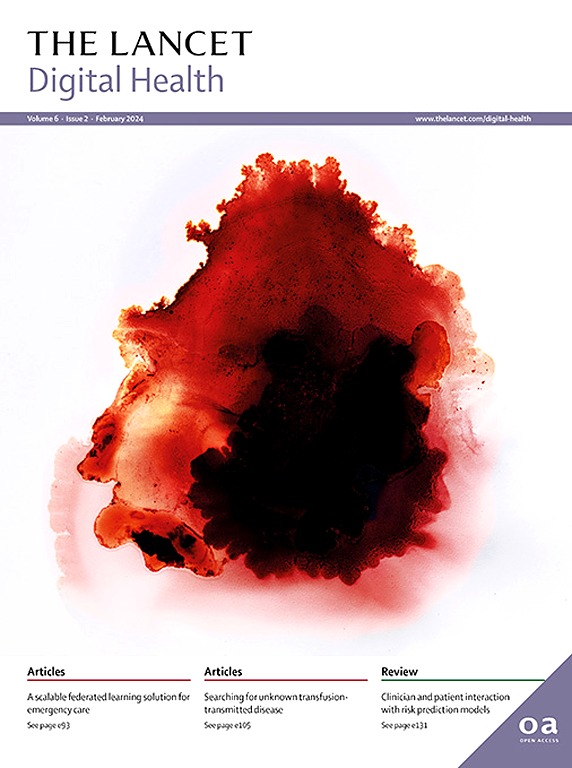Electrocardiogram-based deep learning to predict left ventricular systolic dysfunction in paediatric and adult congenital heart disease in the USA: a multicentre modelling study
IF 24.1
1区 医学
Q1 MEDICAL INFORMATICS
引用次数: 0
Abstract
Background
Left ventricular systolic dysfunction (LVSD) is independently associated with cardiovascular events in patients with congenital heart disease. Although artificial intelligence-enhanced electrocardiogram (AI-ECG) analysis is predictive of LVSD in the general adult population, it has yet to be applied comprehensively across congenital heart disease lesions.
Methods
We trained a convolutional neural network on paired ECG–echocardiograms (≤2 days apart) across the lifespan of a wide range of congenital heart disease lesions to detect left ventricular ejection fraction (LVEF) of 40% or less. Model performance was evaluated on single ECG–echocardiogram pairs per patient at Boston Children's Hospital (Boston, MA, USA) and externally at the Children's Hospital of Philadelphia (Philadelphia, PA, USA) using area under the receiver operating (AUROC) and precision-recall (AUPRC) curves.
Findings
The training cohort comprised 124 265 ECG–echocardiogram pairs (49 158 patients; median age 10·5 years [IQR 3·5–16·8]; 3381 [2·7%] of 124 265 ECG–echocardiogram pairs with LVEF ≤40%). Test groups included internal testing (21 068 patients; median age 10·9 years [IQR 3·7–17·0]; 3381 [2·7%] of 124 265 ECG–echocardiogram pairs with LVEF ≤40%) and external validation (42 984 patients; median age 10·8 years [IQR 4·9–15·0]; 1313 [1·7%] of 76 400 ECG–echocardiogram pairs with LVEF ≤40%) cohorts. High model performance was achieved during internal testing (AUROC 0·95, AUPRC 0·33) and external validation (AUROC 0·96, AUPRC 0·25) for a wide range of congenital heart disease lesions. Patients with LVEF greater than 40% by echocardiogram who were deemed high risk by AI-ECG were more likely to have future dysfunction compared with low-risk patients (hazard ratio 12·1 [95% CI 8·4–17·3]; p<0·0001). High-risk patients by AI-ECG were at increased risk of mortality in the overall cohort and lesion-specific subgroups. Common salient features highlighted across congenital heart disaese lesions include precordial QRS complexes and T waves, with common high-risk ECG features including deep V2 S waves and lateral precordial T wave inversion. A case study on patients with ventricular pacing showed similar findings.
Interpretation
Our externally validated algorithm shows promise in prediction of current and future LVSD in patients with congenital heart disease, providing a clinically impactful, inexpensive, and convenient cardiovascular health tool in this population.
Funding
Kostin Innovation Fund, Thrasher Research Fund Early Career Award, Boston Children's Hospital Electrophysiology Research Education Fund, National Institutes of Health, National Institute of Childhood Diseases and Human Development, and National Library of Medicine.
基于心电图的深度学习预测美国儿童和成人先天性心脏病左心室收缩功能障碍:一项多中心建模研究
背景:先天性心脏病患者左心室收缩功能障碍(LVSD)与心血管事件独立相关。虽然人工智能增强心电图(AI-ECG)分析可以预测一般成人人群的LVSD,但尚未在先天性心脏病病变中全面应用。方法采用卷积神经网络,对各种先天性心脏病病变的成对心电图超声心动图(间隔≤2天)进行训练,检测左室射血分数(LVEF)在40%或以下。在波士顿儿童医院(Boston, MA, USA)和费城儿童医院(Philadelphia, PA, USA)使用受者操作下面积(AUROC)和精确召回率(AUPRC)曲线对每位患者的单对ecg -超声心动图进行模型性能评估。结果:训练队列包括1224265对心电图超声心动图(49158例患者;中位年龄10.5岁[IQR 3.5 ~ 16.8];12265对心电图超声心动图中LVEF≤40%的3381对(2.7%)。试验组包括内测组(21068例);中位年龄10.9岁[IQR 3.7 ~ 17.0];124 265对心电图超声心动图中LVEF≤40%的3381例(2.7%)和外部验证(42 984例);中位年龄10.8岁[IQR 4.9 ~ 15.0];76400对心电图超声心动图(LVEF≤40%)中的1313对(1.7%)队列。在广泛的先天性心脏病病变的内部测试(AUROC 0.95, AUPRC 0.33)和外部验证(AUROC 0.96, AUPRC 0.25)中,模型取得了很高的性能。超声心动图LVEF大于40%的患者与低危患者相比,AI-ECG认为高风险的患者未来发生功能障碍的可能性更大(风险比12.1 [95% CI 8.4 - 17.3];术;0·0001)。AI-ECG显示的高危患者在整个队列和病变特异性亚组中死亡风险增加。先天性心脏病病变中常见的突出特征包括心前QRS复合物和T波,常见的高危心电图特征包括深V2 S波和心前侧T波反转。一项关于心室起搏患者的案例研究显示了类似的结果。我们的外部验证算法在预测先天性心脏病患者当前和未来的LVSD方面显示出前景,为这一人群提供了一种临床有效、廉价和方便的心血管健康工具。资助项目:kostin创新基金、Thrasher研究基金早期职业奖、波士顿儿童医院电生理学研究教育基金、美国国立卫生研究院、美国国家儿童疾病与人类发展研究所、美国国家医学图书馆。
本文章由计算机程序翻译,如有差异,请以英文原文为准。
求助全文
约1分钟内获得全文
求助全文
来源期刊

Lancet Digital Health
Multiple-
CiteScore
41.20
自引率
1.60%
发文量
232
审稿时长
13 weeks
期刊介绍:
The Lancet Digital Health publishes important, innovative, and practice-changing research on any topic connected with digital technology in clinical medicine, public health, and global health.
The journal’s open access content crosses subject boundaries, building bridges between health professionals and researchers.By bringing together the most important advances in this multidisciplinary field,The Lancet Digital Health is the most prominent publishing venue in digital health.
We publish a range of content types including Articles,Review, Comment, and Correspondence, contributing to promoting digital technologies in health practice worldwide.
 求助内容:
求助内容: 应助结果提醒方式:
应助结果提醒方式:


